Hessian polyhedron
In geometry, the Hessian polyhedron is a regular complex polyhedron 3{3}3{3}3, ![]()
![]()
![]()
![]()
![]()
| Hessian polyhedron | |
|---|---|
 Orthographic projection (triangular 3-edges outlined as black edges) | |
| Schläfli symbol | 3{3}3{3}3 |
| Coxeter diagram | |
| Faces | 27 3{3}3 |
| Edges | 72 3{} |
| Vertices | 27 |
| Petrie polygon | Dodecagon |
| van Oss polygon | 12 3{4}2 |
| Shephard group | L3 = 3[3]3[3]3, order 648 |
| Dual polyhedron | Self-dual |
| Properties | Regular |
Coxeter named it after Ludwig Otto Hesse for sharing the Hessian configuration or (94123), 9 points lying by threes on twelve lines, with four lines through each point.[1]
Its complex reflection group is 3[3]3[3]3 or ![]()
![]()
![]()
![]()
![]()
![]()
![]()
![]()
The Witting polytope, 3{3}3{3}3{3}3, ![]()
![]()
![]()
![]()
![]()
![]()
![]()
It has a real representation as the 221 polytope, ![]()
![]()
![]()
![]()
![]()
![]()
![]()
Coordinates
Its 27 vertices can be given coordinates in : for (λ, μ = 0,1,2).
- (0,ωλ,−ωμ)
- (−ωμ,0,ωλ)
- (ωλ,−ωμ,0)
where .
As a Configuration
 Hessian polyhedron with triangular 3-edges outlined as black edges, with one face outlined as blue. |
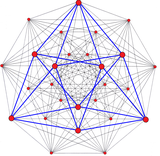 One of 12 Van oss polygons, 3{4}2, in the Hessian polyhedron |
Its symmetry is given by 3[3]3[3]3 or ![]()
![]()
![]()
![]()
![]()
The configuation matrix for 3{3}3{3}3 is:[3]
The number of k-face elements (f-vectors) can be read down the diagonal. The number of elements of each k-face are in rows below the diagonal. The number of elements of each k-figure are in rows above the diagonal.
| L3 | k-face | fk | f0 | f1 | f2 | k-fig | Notes | |
|---|---|---|---|---|---|---|---|---|
| L2 | ( ) | f0 | 27 | 8 | 8 | 3{3}3 | L3/L2 = 27*4!/4! = 27 | |
| L1L1 | 3{ } | f1 | 3 | 72 | 3 | 3{ } | L3/L1L1 = 27*4!/9 = 72 | |
| L2 | 3{3}3 | f2 | 8 | 8 | 27 | ( ) | L3/L2 = 27*4!/4! = 27 |
Images
These are 8 symmetric orthographic projections, some with overlapping vertices, shown by colors. Here the 72 triangular edges are drawn as 3-separate edges.
| E6 [12] |
Aut(E6) [18/2] |
D5 [8] |
D4 / A2 [6] |
|---|---|---|---|
 (1=red,3=orange) |
 (1) |
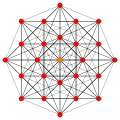 (1,3) |
 (3,9) |
| B6 [12/2] |
A5 [6] |
A4 [5] |
A3 / D3 [4] |
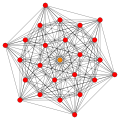 (1,3) |
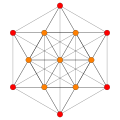 (1,3) |
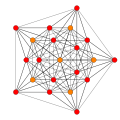 (1,2) |
 (1,4,7) |
Related complex polyhedra
| Double Hessian polyhedron | |
|---|---|
| Schläfli symbol | 2{4}3{3}3 |
| Coxeter diagram | |
| Faces | 72 2{4}3  |
| Edges | 216 {} |
| Vertices | 54 |
| Petrie polygon | Octadecagon |
| van Oss polygon | {6}  |
| Shephard group | M3 = 3[3]3[4]2, order 1296 |
| Dual polyhedron | Rectified Hessian polyhedron, 3{3}3{4}2 |
| Properties | Regular |
The Hessian polyhedron can be seen as an alternation of ![]()
![]()
![]()
![]()
![]()
![]()
![]()
![]()
![]()
![]()
![]()
![]()
![]()
![]()
![]()
![]()
![]()
![]()
![]()
![]()
![]()
![]()
![]()
![]()
![]()
![]()
![]()
![]()
Its complex reflection group is 3[3]3[4]2, or ![]()
![]()
![]()
![]()
![]()
![]()
![]()
![]()
Coxeter noted that the three complex polytopes ![]()
![]()
![]()
![]()
![]()
![]()
![]()
![]()
![]()
![]()
![]()
![]()
![]()
![]()
![]()
![]()
![]()
![]()
![]()
![]()
![]()
![]()
![]()
![]()
![]()
![]()
![]()
![]()
![]()
![]()
Its real representation 54 vertices are contained by two 221 polytopes in symmetric configurations: ![]()
![]()
![]()
![]()
![]()
![]()
![]()
![]()
![]()
![]()
![]()
![]()
![]()
![]()
Construction
The elements can be seen in a configuration matrix:
| M3 | k-face | fk | f0 | f1 | f2 | k-fig | Notes | |
|---|---|---|---|---|---|---|---|---|
| L2 | ( ) | f0 | 54 | 8 | 8 | 3{3}3 | M3/L2 = 1296/24 = 54 | |
| L1A1 | { } | f1 | 2 | 216 | 3 | 3{ } | M3/L1A1 = 1296/6 = 216 | |
| M2 | 2{4}3 | f2 | 6 | 9 | 72 | ( ) | M3/M2 = 1296/18 = 72 |
Images
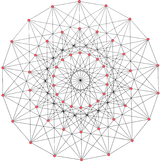 |
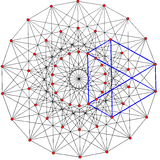 |
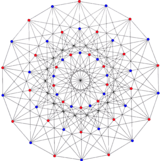 |
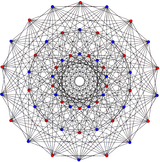 |
Rectified Hessian polyhedron
| Rectified Hessian polyhedron | |
|---|---|
| Schläfli symbol | 3{3}3{4}2 |
| Coxeter diagrams | |
| Faces | 54 3{3}3 |
| Edges | 216 3{} |
| Vertices | 72 |
| Petrie polygon | Octadecagon |
| van Oss polygon | 9 3{4}3 |
| Shephard group | M3 = 3[3]3[4]2, order 1296 3[3]3[3]3, order 648 |
| Dual polyhedron | Double Hessian polyhedron 2{4}3{3}3 |
| Properties | Regular |
The rectification, ![]()
![]()
![]()
![]()
![]()
![]()
![]()
![]()
![]()
![]()
It has a real representation as the 122 polytope, ![]()
![]()
![]()
![]()
![]()
![]()
![]()
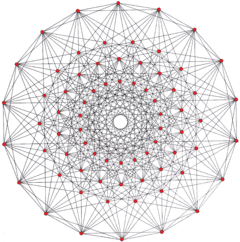 |
 |
 |
Construction
The elements can be seen in two configuration matrices, a regular and quasiregular form.
| M3 | k-face | fk | f0 | f1 | f2 | k-fig | Notes | |
|---|---|---|---|---|---|---|---|---|
| ( ) | f0 | 72 | 9 | 6 | 3{4}2 | M3/M2 = 1296/18 = 72 | ||
| L1A1 | 3{ } | f1 | 3 | 216 | 2 | { } | M3/L1A1 = 1296/3/2 = 216 | |
| L2 | 3{3}3 | f2 | 8 | 8 | 54 | ( ) | M3/L2 = 1296/24 = 54 |
| L3 | k-face | fk | f0 | f1 | f2 | k-fig | Notes | ||
|---|---|---|---|---|---|---|---|---|---|
| L1L1 | ( ) | f0 | 72 | 9 | 3 | 3 | 3{ }×3{ } | L3/L1L1 = 648/9 = 72 | |
| L1 | 3{ } | f1 | 3 | 216 | 1 | 1 | { } | L3/L1 = 648/3 = 216 | |
| L2 | 3{3}3 | f2 | 8 | 8 | 27 | * | ( ) | L3/L2 = 648/24 = 27 | |
| 8 | 8 | * | 27 | ||||||
References
- Coxeter, Complex Regular polytopes, p.123
- Coxeter Regular Convex Polytopes, 12.5 The Witting polytope
- Coxeter, Complex Regular polytopes, p.132
- Coxeter, Complex Regular Polytopes, p.127
- Coxeter, H. S. M., Regular Complex Polytopes, second edition, Cambridge University Press, (1991). p.30 and p.47
- Coxeter, H. S. M. and Moser, W. O. J.; Generators and Relations for Discrete Groups (1965), esp pp 67–80.
- Coxeter, H. S. M.; Regular Complex Polytopes, Cambridge University Press, (1974).
- Coxeter, H. S. M. and Shephard, G.C.; Portraits of a family of complex polytopes, Leonardo Vol 25, No 3/4, (1992), pp 239–244,